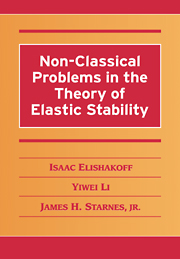Book contents
- Frontmatter
- Contents
- Preface: Why Still Another Book on Stability?
- 1 Mode Localization in Buckling of Structures
- 2 Deterministic Problems of Shells with Variable Thickness
- 3 Stochastic Buckling of Structures: Monte Carlo Method
- 4 Stochastic Buckling of Structures: Analytical and Numerical Non-Monte Carlo Techniques
- 5 Anti-Optimization in Buckling of Structures
- 6 Application of the Godunov-Conte Shooting Method to Buckling Analysis
- 7 Application of Computerized Symbolic Algebra in Buckling Analysis
- Bibliography
- Author Index
- Subject Index
3 - Stochastic Buckling of Structures: Monte Carlo Method
Published online by Cambridge University Press: 06 January 2010
- Frontmatter
- Contents
- Preface: Why Still Another Book on Stability?
- 1 Mode Localization in Buckling of Structures
- 2 Deterministic Problems of Shells with Variable Thickness
- 3 Stochastic Buckling of Structures: Monte Carlo Method
- 4 Stochastic Buckling of Structures: Analytical and Numerical Non-Monte Carlo Techniques
- 5 Anti-Optimization in Buckling of Structures
- 6 Application of the Godunov-Conte Shooting Method to Buckling Analysis
- 7 Application of Computerized Symbolic Algebra in Buckling Analysis
- Bibliography
- Author Index
- Subject Index
Summary
Most calculations of imperfection-sensitivity have been carried out for simple shapes of the imperfection distribution, selected for convenience of analysis. It is generally realized, of course, that actual imperfections are unlikely to follow this regular pattern.
W. T. KoiterThere is a close connection between the concepts of stability and probability. Stable states of equilibrium or motion observed in the natural or engineering systems are the most probable ones; unstable ones are improbable and even unrealizable. The more stable a state is, the greater is the probability of its realization. Hence follows the connection between the concepts of stability and reliability.
V. V. BolotinBut to us, probability is the very guide of life.
J. ButlerIn this chapter, we treat initial geometric imperfections as spacewise random functions (i.e., random fields). As a result, the buckling load the maximum load the structure can sustain turns out to be a random. We focus our attention on reliability of the shells, namely the probability that a structure will not fail prior to the specified load. We develop efficient techniques of simulation of random fields, based on the knowledge of the mean initial imperfection function and the auto-correlation function. This allows us to conduct, by the Monte Carlo method, an extensive analysis of the buckling of columns on non-linear elastic foundations and of circular cylindrical shells. We consider the cases of both axisymmetric and general, non-symmetric imperfections.
- Type
- Chapter
- Information
- Non-Classical Problems in the Theory of Elastic Stability , pp. 107 - 174Publisher: Cambridge University PressPrint publication year: 2001



